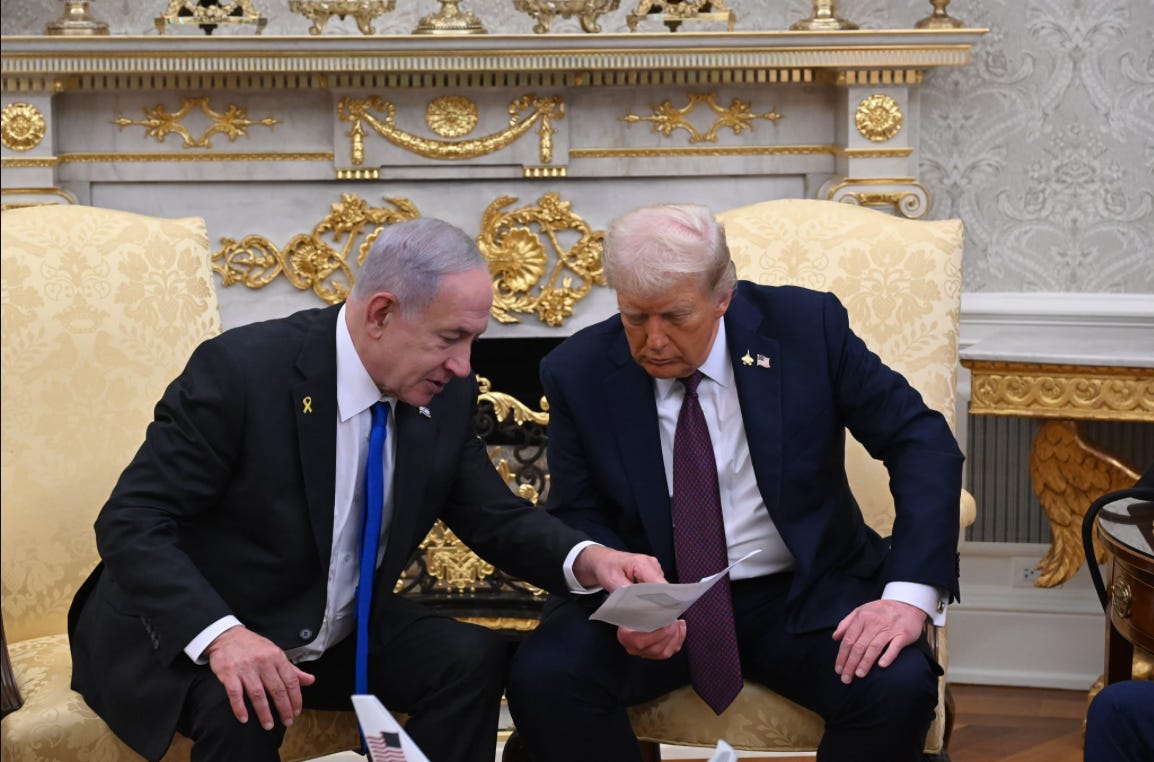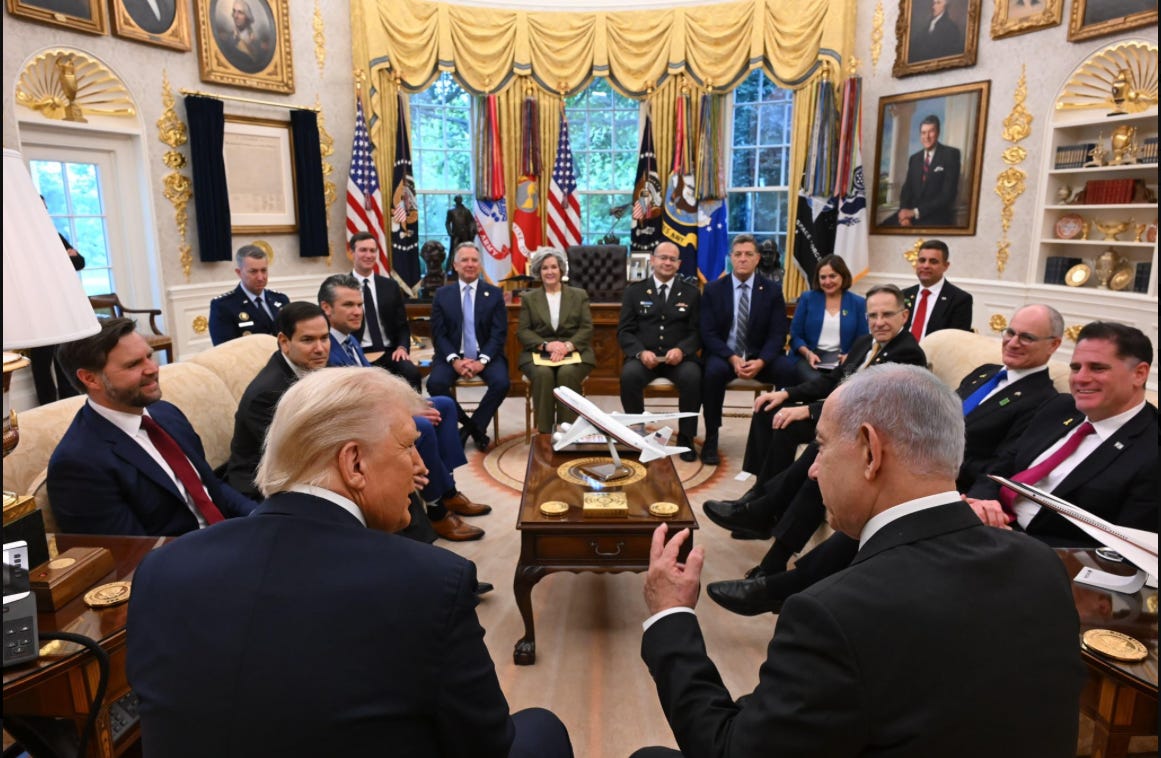DAY OF 724 OF THE WAR: Netanyahu Accepts Trump’s Proposal to End the War and Release the Hostages; The Arab World and Europe Announce Their Support
Tel Aviv Diary, September 29, 2025
It was a day of waiting, waiting for tonight’s press conference and the meeting between President Trump and Prime Minister Netanyahu—and while we waited, the war went on.
Late last night, as I was preparing to go to sleep, an alert flashed, warning a missile had been launched from Yemen, and air raid sirens in our area would soon follow. Instead of climbing into bed, I laced up my shoes and we readied ourselves for the shelter. Three minutes later, the sirens wailed.
INSIDE GAZA
Fighting continued today in Gaza City itself. A group of five Hamas terrorists struck an Israeli position where tanks were stationed, planting explosive devices on two of them. The attack left five soldiers (two officers and three enlisted men) critically wounded, with several others sustaining lighter injuries. Additional soldiers were also lightly wounded. Two of the Hamas terrorists were killed. The fate of the remaining three is not yet known.
NETANYAHU VISITS THE WHITE HOUSE
Tonight, as we waited for the press conference, reports emerged that Prime Minister Netanyahu had been compelled to call the Emir of Qatar. In that conversation, Netanyahu apologized for the Qatari citizen killed during Israel’s strike on Hamas leaders in Doha. He also expressed regret for the violation of Qatari sovereignty and pledged it would not be repeated. President Trump later announced the creation of a joint working group aimed at improving relations among the three countries.
TRUMP’S 20-POINT PLAN
And then came the day’s main story … After a three-hour meeting between President Trump and Prime Minister Netanyahu, the White House released the details of the long-awaited plan.
FOR IMMEDIATE RELEASE 09/29/25 President Donald J. Trump’s Comprehensive Plan to End the Gaza Conflict
Gaza will be a deradicalized terror-free zone that does not pose a threat to its neighbors.
Gaza will be redeveloped for the benefit of the people of Gaza, who have suffered more than enough.
If both sides agree to this proposal, the war will immediately end. Israeli forces will withdraw to the agreed upon line to prepare for a hostage release. During this time, all military operations, including aerial and artillery bombardment, will be suspended, and battle lines will remain frozen until conditions are met for the complete staged withdrawal.
Within 72 hours of Israel publicly accepting this agreement, all hostages, alive and deceased, will be returned.
Once all hostages are released, Israel will release 250 life sentence prisoners plus 1700 Gazans who were detained after October 7th 2023, including all women and children detained in that context. For every Israeli hostage whose remains are released, Israel will release the remains of 15 deceased Gazans.
Once all hostages are returned, Hamas members who commit to peaceful coexistence and to decommission their weapons will be given amnesty. Members of Hamas who wish to leave Gaza will be provided safe passage to receiving countries.
Upon acceptance of this agreement, full aid will be immediately sent into the Gaza Strip. At a minimum, aid quantities will be consistent with what was included in the January 19, 2025, agreement regarding humanitarian aid, including rehabilitation of infrastructure (water, electricity, sewage), rehabilitation of hospitals and bakeries, and entry of necessary equipment to remove rubble and open roads.
Entry of distribution and aid in the Gaza Strip will proceed without interference from the two parties through the United Nations and its agencies, and the Red Crescent, in addition to other international institutions not associated in any manner with either party. Opening the Rafah crossing in both directions will be subject to the same mechanism implemented under the January 19, 2025 agreement.
Gaza will be governed under the temporary transitional governance of a technocratic, apolitical Palestinian committee, responsible for delivering the day-to-day running of public services and municipalities for the people in Gaza. This committee will be made up of qualified Palestinians and international experts, with oversight and supervision by a new international transitional body, the “Board of Peace,” which will be headed and chaired by President Donald J. Trump, with other members and heads of State to be announced, including Former Prime Minister Tony Blair. This body will set the framework and handle the funding for the redevelopment of Gaza until such time as the Palestinian Authority has completed its reform program, as outlined in various proposals, including President Trump’s peace plan in 2020 and the Saudi-French proposal, and can securely and effectively take back control of Gaza. This body will call on best international standards to create modern and efficient governance that serves the people of Gaza and is conducive to attracting investment.
A Trump economic development plan to rebuild and energize Gaza will be created by convening a panel of experts who have helped birth some of the thriving modern miracle cities in the Middle East. Many thoughtful investment proposals and exciting development ideas have been crafted by well-meaning international groups, and will be considered to synthesize the security and governance frameworks to attract and facilitate these investments that will create jobs, opportunity, and hope for future Gaza.
A special economic zone will be established with preferred tariff and access rates to be negotiated with participating countries.
No one will be forced to leave Gaza, and those who wish to leave will be free to do so and free to return. We will encourage people to stay and offer them the opportunity to build a better Gaza.
Hamas and other factions agree to not have any role in the governance of Gaza, directly, indirectly, or in any form. All military, terror, and offensive infrastructure, including tunnels and weapon production facilities, will be destroyed and not rebuilt.
There will be a process of demilitarization of Gaza under the supervision of independent monitors, which will include placing weapons permanently beyond use through an agreed process of decommissioning, and supported by an internationally funded buy back and reintegration program all verified by the independent monitors.
New Gaza will be fully committed to building a prosperous economy and to peaceful coexistence with their neighbors.
A guarantee will be provided by regional partners to ensure that Hamas, and the factions, comply with their obligations and that New Gaza poses no threat to its neighbors or its people.
The United States will work with Arab and international partners to develop a temporary International Stabilization Force (ISF) to immediately deploy in Gaza. The ISF will train and provide support to vetted Palestinian police forces in Gaza, and will consult with Jordan and Egypt who have extensive experience in this field. This force will be the long-term internal security solution. The ISF will work with Israel and Egypt to help secure border areas, along with newly trained Palestinian police forces.
It is critical to prevent munitions from entering Gaza and to facilitate the rapid and secure flow of goods to rebuild and revitalize Gaza. A deconfliction mechanism will be agreed upon by the parties.
Israel will not occupy or annex Gaza. As the ISF establishes control and stability, the Israel Defense Forces (IDF) will withdraw based on standards, milestones, and timeframes linked to demilitarization that will be agreed upon between the IDF, ISF, the guarantors, and the Unites States, with the objective of a secure Gaza that no longer poses a threat to Israel, Egypt, or its citizens. Practically, the IDF will progressively hand over the Gaza territory it occupies to the ISF according to an agreement they will make with the transitional authority until they are withdrawn completely from Gaza, save for a security perimeter presence that will remain until Gaza is properly secure from any resurgent terror threat.
In the event Hamas delays or rejects this proposal, the above, including the scaled-up aid operation, will proceed in the terror-free areas handed over from the IDF to the ISF.
An interfaith dialogue process will be established based on the values of tolerance and peaceful co-existence to try and change mindsets and narratives of Palestinians and Israelis by emphasizing the benefits that can be derived from peace.
While Gaza re-development advances and when the PA reform program is faithfully carried out, the conditions may finally be in place for a credible pathway to Palestinian self-determination and statehood, which we recognize as the aspiration of the Palestinian people.
The United States will establish a dialogue between Israel and the Palestinians to agree on a political horizon for peaceful and prosperous co-existence.
President Trump opened the press conference and spoke for roughly 30 minutes, declaring it a “tremendous, historic day”— the most important in thousands of years, he said, marking a step toward ending what he called “a thousand-year conflict”. I’ll give Trump a pass on his historic inaccuracies. For the record … Jews have had disputes with other peoples for millennia. However, the Israeli-Palestinian conflict itself is little more than a century old, beginning with the rise of modern Zionism. But, let’s leave that aside.
Trump went on to say he would take personal responsibility for what he dubbed the “peace council,” a body of leaders from around the world tasked with drafting a plan for Gaza. i.e., its reconstruction, its governance, and its demilitarization. I won’t try to go into all the details of what Trump said. Some of it was just rambling, and he appeared very fatigued. But one key point stood out: his hope that this initiative could serve as the foundation for a broader regional peace.
Netanyahu then took the stage and formally accepted the plan. He emphasized, however, that if Hamas rejected it, Israel would—as President Trump had said—have a green light to “finish the job,” meaning the army would press ahead militarily. Netanyahu also stressed that the Palestinian Authority would be included in the framework only if it underwent sweeping reforms. Whether even that limited role will be acceptable to some of his coalition partners remains uncertain.
The chief advantage of Trump’s plan is that both Qatar, and apparently Turkey, are prepared to support the proposal. The main obstacle, of course, is Hamas. For them, agreeing to the plan would essentially mean surrender, which is precisely the outcome Israel seeks. But will they agree? That remains the central question.
Can Qatar and Turkey exert enough pressure on Hamas? Unclear. Just as uncertain is whether President Trump will sustain his interest in this effort over time. That’s the real question here. If Hamas were to accept, it would be a breakthrough.
One point needs to be clearly said: for the first time, there is now a framework for the future of Gaza that both the Arab world and Israel have accepted and are willing to work towards. The Arab and Muslim states Trump met with last week issued a joint statement praising the plan and pledging their support. This means the dream of reestablishing Israeli settlements in Gaza is finished. Whether or not an agreement is reached in the coming days, at least a vision for the future has finally taken shape.
In the end, no questions were taken. The event felt less like a press conference than a prepared statement.
Hopefully, I’ll have more to say tomorrow, and perhaps I’ll record a podcast to explore the subject further.
Today's Radio Show
ECONOMY
The Bank of Israel kept its benchmark interest rate unchanged at 4.5% on Monday,
Keep reading with a 7-day free trial
Subscribe to Tel Aviv Diary to keep reading this post and get 7 days of free access to the full post archives.



